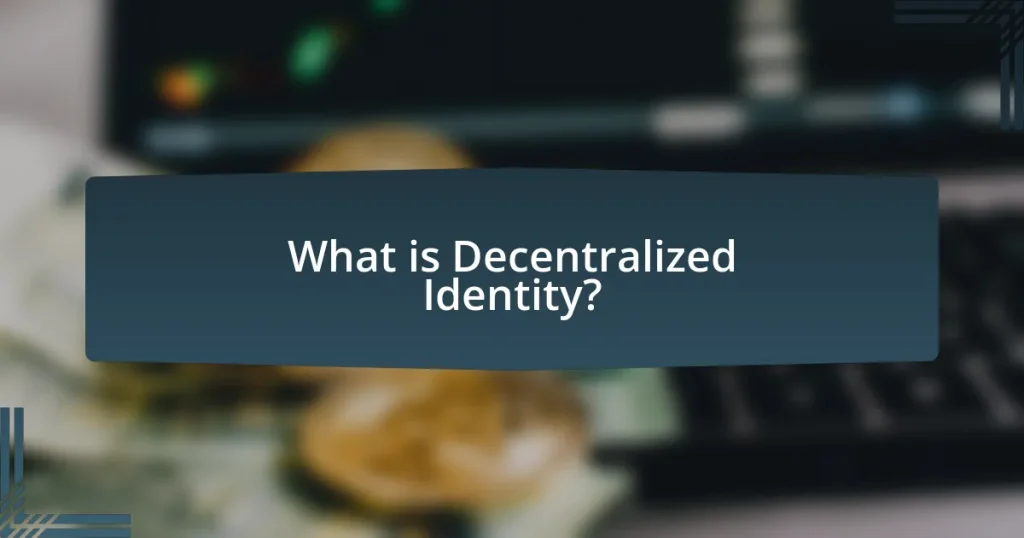Decentralized Identity is a digital identity model that empowers individuals to manage their personal information without relying on centralized authorities, utilizing blockchain technology for enhanced security and privacy. This article explores the differences between decentralized and traditional identity systems, highlighting key features such as user control, privacy, security, and interoperability. It also addresses the challenges faced by decentralized identity, including regulatory compliance and technological barriers, while examining its implementation in various industries and future prospects. The discussion emphasizes the importance of user education and best practices for organizations adopting decentralized identity solutions to ensure privacy and data protection.

What is Decentralized Identity?
Decentralized Identity is a digital identity model that allows individuals to control their personal information without relying on a central authority. This approach leverages blockchain technology to create secure, verifiable identities that can be managed by the individual, ensuring privacy and reducing the risk of identity theft. According to the World Economic Forum, decentralized identity systems can enhance security and user autonomy by enabling users to share only the necessary information for specific transactions, thus minimizing data exposure.
How does Decentralized Identity differ from traditional identity systems?
Decentralized Identity differs from traditional identity systems primarily in its structure and control. In traditional identity systems, a central authority, such as a government or corporation, manages and verifies identities, leading to potential vulnerabilities and privacy concerns. In contrast, Decentralized Identity allows individuals to control their own identity information through blockchain technology, enabling secure, peer-to-peer verification without reliance on a central authority. This shift enhances user privacy and reduces the risk of data breaches, as evidenced by the increasing adoption of decentralized identity solutions in various sectors, including finance and healthcare, which prioritize user autonomy and security.
What are the key features of Decentralized Identity?
The key features of Decentralized Identity include user control, privacy, security, and interoperability. User control allows individuals to manage their own identity without relying on centralized authorities, enabling them to share only necessary information. Privacy is enhanced as users can selectively disclose their data, reducing the risk of data breaches. Security is strengthened through cryptographic techniques that protect identity information from unauthorized access. Interoperability ensures that decentralized identities can be used across different platforms and services, facilitating seamless interactions. These features collectively empower users and enhance trust in digital identity systems.
Why is privacy a significant concern in identity management?
Privacy is a significant concern in identity management because it directly impacts individuals’ control over their personal information. In identity management systems, sensitive data such as names, addresses, and biometric information can be vulnerable to unauthorized access and misuse. For instance, a 2020 report by the Identity Theft Resource Center indicated that data breaches exposed over 37 billion records, highlighting the risks associated with inadequate privacy measures. Ensuring privacy in identity management not only protects individuals from identity theft but also fosters trust in digital systems, which is essential for the adoption of decentralized identity solutions in blockchain technology.
What are the core principles of Decentralized Identity?
The core principles of Decentralized Identity include user control, privacy, security, and interoperability. User control allows individuals to manage their own identities without reliance on centralized authorities, ensuring that they have ownership over their personal data. Privacy is maintained through cryptographic techniques that protect sensitive information, allowing users to share only what is necessary. Security is enhanced by decentralized networks that reduce the risk of data breaches associated with centralized systems. Interoperability ensures that decentralized identities can be used across various platforms and services, promoting seamless user experiences. These principles collectively empower users and enhance trust in digital interactions.
How does user control play a role in Decentralized Identity?
User control is fundamental in Decentralized Identity as it empowers individuals to manage their own identity data without relying on centralized authorities. This autonomy allows users to selectively share personal information with service providers, enhancing privacy and security. For instance, in a decentralized identity system, users can utilize cryptographic keys to authenticate themselves, ensuring that only they have access to their identity credentials. This model contrasts with traditional identity systems, where centralized entities hold and control user data, often leading to vulnerabilities and data breaches. By enabling user control, decentralized identity frameworks promote trust and reduce the risks associated with identity theft and misuse of personal information.
What is the importance of interoperability in Decentralized Identity?
Interoperability in Decentralized Identity is crucial as it enables different identity systems to work together seamlessly. This interconnectedness allows users to manage their identities across various platforms without needing multiple credentials, enhancing user experience and security. For instance, the World Wide Web Consortium (W3C) has established standards like Decentralized Identifiers (DIDs) and Verifiable Credentials, which facilitate interoperability among different identity solutions. This standardization is essential for fostering trust and adoption in decentralized identity systems, as it ensures that identities can be verified and utilized across diverse applications and services.
What challenges does Decentralized Identity face?
Decentralized Identity faces several challenges, including interoperability, user adoption, and regulatory compliance. Interoperability issues arise because different decentralized identity systems may not communicate effectively with each other, hindering seamless user experiences. User adoption is a challenge as individuals and organizations may be hesitant to transition from traditional identity systems due to a lack of understanding or perceived risks. Regulatory compliance presents difficulties as existing laws and regulations may not adequately address the unique aspects of decentralized identity, leading to uncertainty for developers and users alike. These challenges must be addressed to realize the full potential of decentralized identity in blockchain technology.
How do regulatory issues impact the adoption of Decentralized Identity?
Regulatory issues significantly hinder the adoption of Decentralized Identity by creating uncertainty and compliance challenges for organizations. These regulations often require strict adherence to data protection laws, such as the General Data Protection Regulation (GDPR) in Europe, which can complicate the implementation of decentralized systems that prioritize user control over personal data. Furthermore, regulatory bodies may lack a clear framework for recognizing and validating decentralized identity solutions, leading to hesitance among businesses to invest in or adopt these technologies. The lack of standardized regulations can also result in fragmented approaches across different jurisdictions, making it difficult for companies to navigate the legal landscape and achieve interoperability.
What technological barriers exist for implementing Decentralized Identity?
Technological barriers for implementing Decentralized Identity include interoperability issues, scalability challenges, and security concerns. Interoperability issues arise because different decentralized identity systems may not communicate effectively with one another, hindering user experience and adoption. Scalability challenges are significant as the infrastructure must handle a growing number of users and transactions without compromising performance. Security concerns involve the potential for data breaches and the need for robust cryptographic measures to protect user identities. These barriers must be addressed to facilitate widespread adoption of decentralized identity solutions.

How is Decentralized Identity implemented in blockchain technology?
Decentralized Identity is implemented in blockchain technology through the use of self-sovereign identity (SSI) frameworks that allow individuals to control their own identity data without relying on centralized authorities. This implementation typically involves the creation of a digital identity that is anchored on a blockchain, where users can generate cryptographic keys to manage their identity credentials securely.
For instance, platforms like Sovrin and uPort utilize blockchain to store and verify identity attributes, enabling users to share only the necessary information with service providers while maintaining privacy. The decentralized nature of blockchain ensures that identity data is immutable and tamper-proof, enhancing security and trust.
Moreover, the W3C’s Decentralized Identifiers (DIDs) specification provides a standardized approach for creating and managing decentralized identities, further validating the effectiveness of blockchain in this domain.
What role does blockchain play in Decentralized Identity?
Blockchain serves as the foundational technology for Decentralized Identity by enabling secure, tamper-proof storage and management of identity data. This decentralized approach allows individuals to control their own identity information without relying on centralized authorities, reducing the risk of data breaches and identity theft. The immutability of blockchain ensures that once identity data is recorded, it cannot be altered or deleted without consensus, providing a reliable audit trail. Furthermore, blockchain facilitates interoperability among different identity systems, allowing users to share their verified credentials across various platforms seamlessly.
How does blockchain ensure security and trust in identity verification?
Blockchain ensures security and trust in identity verification through its decentralized and immutable nature. By storing identity data across a distributed network of nodes, blockchain eliminates single points of failure and reduces the risk of data tampering. Each transaction or identity verification process is recorded in a block that is cryptographically linked to the previous block, creating a secure chain of information that is resistant to alteration.
Additionally, the use of cryptographic algorithms ensures that only authorized parties can access or modify identity data, enhancing privacy and security. For instance, the implementation of public and private keys allows individuals to control their own identity information, granting access only to trusted entities. This decentralized approach fosters trust among users, as they can independently verify the authenticity of identity claims without relying on a central authority.
The effectiveness of blockchain in identity verification is supported by real-world applications, such as the use of blockchain by the government of Estonia for digital identity services, which has successfully secured the identities of over a million citizens since its launch.
What are the different blockchain protocols used for Decentralized Identity?
Different blockchain protocols used for Decentralized Identity include Ethereum, Hyperledger Indy, Sovrin, and uPort. Ethereum supports smart contracts that facilitate identity management, while Hyperledger Indy is specifically designed for decentralized identity solutions, providing a framework for creating and managing decentralized identifiers. Sovrin operates on a public permissioned blockchain, enabling self-sovereign identity, and uPort offers a platform for users to manage their identities securely. Each of these protocols contributes unique features that enhance the functionality and security of decentralized identity systems.
What are the use cases of Decentralized Identity?
Decentralized Identity has several key use cases, including secure online authentication, self-sovereign identity management, and streamlined KYC (Know Your Customer) processes. In secure online authentication, users can access services without relying on centralized authorities, reducing the risk of data breaches. Self-sovereign identity management allows individuals to control their personal information, sharing only what is necessary for specific transactions, thus enhancing privacy. Streamlined KYC processes benefit businesses by simplifying customer verification while maintaining compliance with regulations, ultimately reducing costs and improving user experience. These use cases demonstrate the practical applications of Decentralized Identity in enhancing security, privacy, and efficiency in digital interactions.
How can Decentralized Identity enhance online security?
Decentralized Identity enhances online security by allowing individuals to control their personal data without relying on centralized authorities. This self-sovereign model reduces the risk of data breaches, as sensitive information is not stored in a single location vulnerable to attacks. According to a report by the World Economic Forum, decentralized identity systems can significantly lower identity theft incidents by enabling users to authenticate themselves using cryptographic proofs rather than sharing personal information. This approach not only protects user privacy but also fosters trust in online interactions, as users can verify identities without exposing their data to potential misuse.
What industries are adopting Decentralized Identity solutions?
Various industries are adopting Decentralized Identity solutions, including finance, healthcare, education, and supply chain management. In finance, companies utilize decentralized identities to enhance security and streamline customer onboarding processes. The healthcare sector employs these solutions to protect patient data while ensuring secure access to medical records. Educational institutions leverage decentralized identities for verifying credentials and streamlining admissions processes. Additionally, supply chain management benefits from decentralized identities by improving transparency and traceability of products. These industries recognize the potential of decentralized identity to enhance security, privacy, and efficiency in their operations.

What are the future prospects of Decentralized Identity?
The future prospects of Decentralized Identity are highly promising, as they offer enhanced security, user control, and interoperability across various platforms. With the increasing demand for privacy and data protection, decentralized identity solutions can empower individuals to manage their personal information without relying on centralized authorities. According to a report by the World Economic Forum, by 2025, 1 billion people are expected to use decentralized identity systems, indicating a significant shift towards this technology. Furthermore, advancements in blockchain technology and regulatory support are likely to accelerate the adoption of decentralized identity frameworks, making them integral to digital identity verification processes in various sectors, including finance, healthcare, and government services.
How might Decentralized Identity evolve in the coming years?
Decentralized Identity is likely to evolve through increased adoption of blockchain technology, enhanced interoperability, and improved user control over personal data. As organizations recognize the benefits of decentralized systems, more platforms will integrate decentralized identity solutions, allowing users to manage their identities across multiple services without relying on centralized authorities. Additionally, advancements in standards such as Decentralized Identifiers (DIDs) and Verifiable Credentials will facilitate seamless interactions between different identity systems, promoting a more interconnected digital ecosystem. This evolution is supported by the growing emphasis on privacy and security, as evidenced by regulatory frameworks like the General Data Protection Regulation (GDPR), which encourage the development of user-centric identity solutions.
What innovations are expected to shape the future of Decentralized Identity?
Innovations expected to shape the future of Decentralized Identity include advancements in blockchain technology, zero-knowledge proofs, and self-sovereign identity frameworks. Blockchain technology enhances security and transparency, allowing users to control their own identity data without relying on centralized authorities. Zero-knowledge proofs enable users to verify their identity without revealing personal information, thus enhancing privacy. Self-sovereign identity frameworks empower individuals to manage their own digital identities, reducing the risk of identity theft and fraud. These innovations collectively aim to create a more secure, user-centric identity management system.
How can Decentralized Identity contribute to a more secure digital ecosystem?
Decentralized Identity can significantly enhance the security of the digital ecosystem by enabling individuals to control their personal data without relying on centralized authorities. This control reduces the risk of data breaches, as users can selectively share information with trusted parties, minimizing exposure to potential threats. According to a report by the World Economic Forum, decentralized identity systems can decrease identity fraud by up to 80% by providing verifiable credentials that are cryptographically secured. This shift towards user empowerment and data sovereignty fosters a more resilient digital environment, where trust is established through secure, peer-to-peer interactions rather than through vulnerable centralized databases.
What best practices should organizations follow when adopting Decentralized Identity?
Organizations should prioritize user control and privacy when adopting Decentralized Identity. This involves implementing systems that allow individuals to manage their own identity data without relying on centralized authorities. Additionally, organizations should ensure interoperability with existing identity systems to facilitate seamless integration and user experience.
Furthermore, adopting strong security measures, such as cryptographic techniques, is essential to protect identity data from unauthorized access and breaches. Organizations should also engage in user education to promote understanding of decentralized identity benefits and functionalities.
Finally, compliance with relevant regulations, such as GDPR, is crucial to ensure legal adherence and build trust with users. These practices collectively enhance the effectiveness and acceptance of Decentralized Identity solutions.
How can organizations ensure user privacy and data protection?
Organizations can ensure user privacy and data protection by implementing decentralized identity solutions that leverage blockchain technology. Decentralized identity allows users to control their personal data, reducing reliance on centralized databases that are vulnerable to breaches. According to a report by the World Economic Forum, decentralized identity systems can significantly enhance security and privacy by enabling users to share only the necessary information without exposing their entire identity. This approach minimizes the risk of data leaks and unauthorized access, as sensitive information is stored securely on the blockchain rather than in a single location.
What steps should be taken to educate users about Decentralized Identity?
To educate users about Decentralized Identity, organizations should implement a multi-faceted approach that includes workshops, online courses, and informative content. Workshops can provide hands-on experience and facilitate discussions, while online courses can offer structured learning paths that cover the principles and applications of Decentralized Identity. Informative content, such as articles, videos, and infographics, can simplify complex concepts and make them accessible to a broader audience.
Research indicates that interactive learning methods, such as workshops, enhance retention and understanding of new technologies (Hattie, J. & Donoghue, G., 2016, “Learning Strategies”). Therefore, combining these educational steps can effectively raise awareness and understanding of Decentralized Identity among users.










